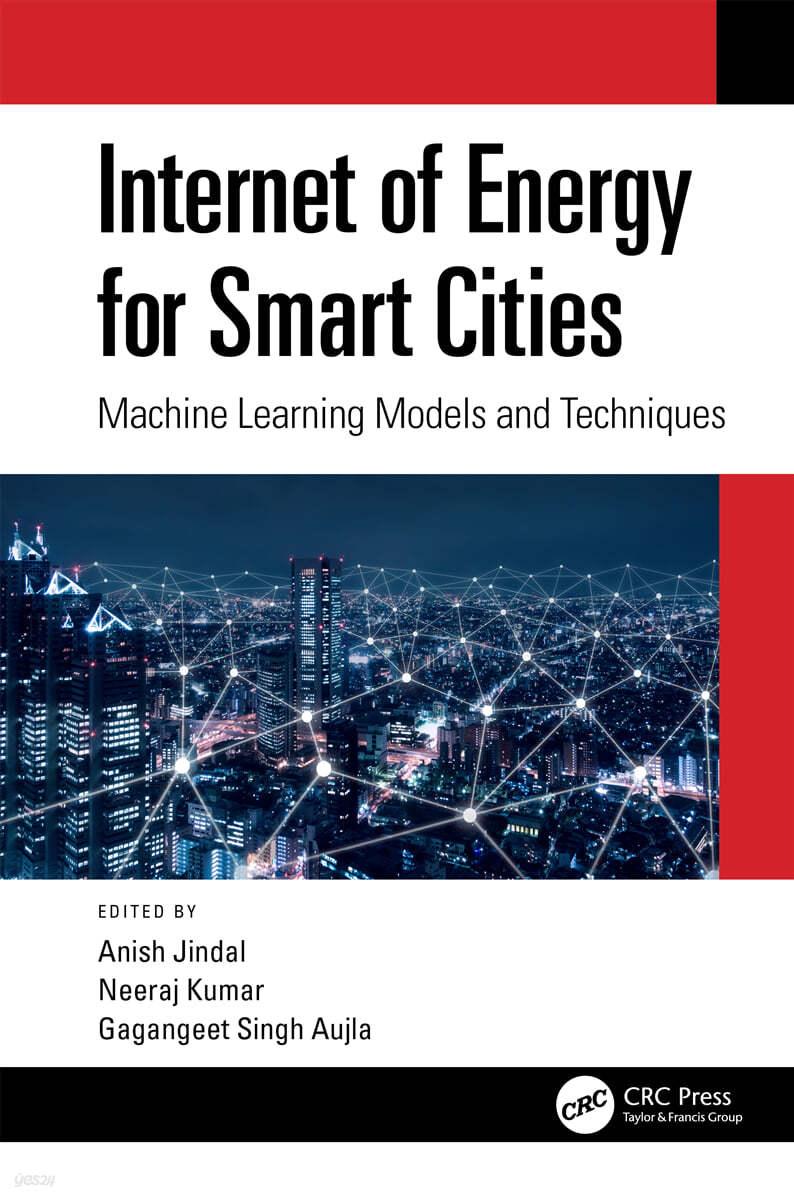책 이미지

책 정보
· 분류 : 외국도서 > 기술공학 > 기술공학 > 전력자원 > 전기 에너지
· ISBN : 9780367497750
· 쪽수 : 322쪽
· 출판일 : 2021-07-20
목차
SECTION I OverviewChapter 1 Smart City: The Verticals of Energy Demand and ChallengesSumedha Sharma, Ashu Verma, and B.K. Panigrahi1.1 Introduction1.2 Smart Energy Distribution 1.2.1 Demand Response1.2.2 Demand Side Management1.3 Real-Time Grid Analytics and Data Management1.3.1 Energy System Operations1.3.2 Energy Management Systems1.3.3 Design and Formulation of Optimizer Model1.3.4 Real-Time Optimization 1.3.4.1 Robust Optimization1.3.4.2 Stochastic Programming with Recourse1.3.4.3 Chance-Constrained Optimization 1.3.5 Big Data Analytics1.3.6 Energy Blockchain1.4 Intelligent Cloud based Grid Applications1.4.1 Centralized Control1.4.2 Decentralized Control1.4.3 Distributed Control 1.4.4 Multi-Agent Systems 1.5 Conclusion SECTION II Smart GridsChapter 2 Conventional Power Grid to Smart Grid Dristi Datta and Nurul I Sarkar2.1 Introduction2.2 Evolution: From Power Grid to Smart Grid 2.3 Benefits of Smart Grid System 2.3.1 Technological Benefits2.3.2 Benefits to Customers 2.3.3 Benefits to Stakeholders2.4 Smart Grid: Standards and Technologies2.4.1 Standards2.4.1.1 Revenue Metering Information Model 2.4.1.2 Building Automation 2.4.1.3 Substation Automation 2.4.1.4 Powerline Networking 2.4.1.5 Home Area Network Device CommunicationMeasurement and Control2.4.1.6 Application-Level Energy ManagementSystems2.4.1.7 Inter-Control and Interoperability CenterCommunications2.4.1.8 Cyber Security 2.4.1.9 Electric Vehicles 2.4.2 Technologies 2.4.2.1 Storage Systems2.4.2.2 Telecommunication Systems 2.4.2.3 ICT Infrastructure2.5 Implementation Aspects 2.6 Challenges of Implementing Smart grid2.6.1 Technical Challenges 2.6.2 Socio-economic Challenges2.6.3 Miscellaneous 2.7 Open Research Questions 2.8 Concluding Remarks Chapter 3 Smart Grids: An Integrated Perspective Rafael S. Salles, B. Isa´ıas Lima Fuly, and Paulo F. Ribeiro3.1 Introduction3.2 Design challenges and philosophical considerations3.2.1 Challenges and Technical Barriers3.2.1.1 Renewable Generation Sources 3.2.1.2 Management and Market Complexity 3.2.1.3 Power Quality Issues 3.2.1.4 Cybersecurity3.2.2 Holistic Normative Engineering Design forSmart Grids 3.3 Smart grid architectures and technologies3.3.1 The Communication Structure and Technologies3.3.2 Smart Metering, Measurements, Control andAutomation 3.3.3 Microgrids and Key Technologies 3.4 Interoperability and scalability3.4.1 Moving for Interoperability in Smart Grids3.4.2 Scalability Aspects for the Modern Grid Model3.5 Applications3.5.1 Distributed Energy Resources Management3.5.2 Energy Storage3.5.3 Metering and Automation SECTION III Internet of Energy (IoE)Chapter 4 Internet of Energy: Solution for Smart CitiesAsh Mohammad Abbas4.1 Introduction4.2 Constituents of Smart Cities 4.2.1 Participation of Citizen 4.2.2 Residential Buildings 4.2.3 Street Lights 4.3 Need of IoE in Smart Cities4.4 Problems to be Solved Using IoE4.5 Operation of IoE 4.6 Integration of Electrical Vehicles to IoE4.7 Infrastructure Required for IoE 4.8 IoE Tools4.9 Conclusion Chapter 5 IoE Applications for Smart CitiesManju Lata and Vikas Kumar5.1 Introduction5.2 Energy Challenges in IoE 5.2.1 Reliability and Scalability5.2.2 Security and Privacy intended for Data Access 5.2.3 Cost and Expenditure5.2.4 Climate Conditions 5.2.5 Legislation5.2.6 Education and Engagement of Citizens 5.2.7 Infrastructure and Capacity Building5.3 Resolutions to IoE Energy Challenges 5.4 Smart Applications of IoE5.5 Conclusion Chapter 6 IoE Design Principles and Architecture Rania Salih Abdalla, Sara A. Mahbub, Rania A. Mokhtar, ElmustafaSayed Ali, and Rashid A. Saeed6.1 Introduction6.2 IoE Architecture Models6.2.1 An EMS-Based Architecture 6.2.2 A Fog Based Architecture6.3 Embedding Intelligence in IoE Design6.3.1 Cloud Computing6.3.2 Fog Computing 6.3.3 Blockchain 6.4 IoE Standards86.4.1 IEEE 2030 Standard6.4.2 IEEE 802.15.4g6.4.3 IEEE 21450 and IEEE 21451 6.4.4 The 4th G -Based Low Power Wide Area (LPWA)6.5 IoE Interoperability6.6 IoE Privacy and Security6.6.1 IoE Cyber Security6.6.2 IoE Hardware Security6.7 Conclusion SECTION IV Machine Learning ModelsChapter 7 Machine Learning Models for Smart Cities Dristi Datta and Nurul I Sarkar7.1 Introduction7.2 Machine Learning Frameworks 7.2.1 Machine Learning Approaches7.2.2 Machine Learning Models 7.2.2.1 Supervised Learning Models7.2.2.2 Unsupervised Learning Models7.2.2.3 Semi-supervised Learning Models7.2.2.4 Reinforcement Learning Model 7.3 Problem-solving using Machine Learning Techniques 7.4 Smart City Design Infrastructure7.5 Smart City Design Challenges7.5.1 Technical Challenges 7.5.2 Social Challenges7.5.3 Economic Challenges7.5.4 Miscellaneous Challenges7.6 Implications of ML Models in the Design of Smart Cities7.7 Concluding Remarks Chapter 8 Machine Learning Models in Smart Cities - Data-Driven PerspectiveSeyed Mahdi Miraftabzadeh, Michela Longo, and Federica Foiadelli8.1 Introduction8.2 Artificial Intelligence and the smart cities 8.3 Machine Learning8.3.1 Categories of machine learning techniques 8.3.2 Big Data and Machine learning 8.4 Data terminology 8.4.1 Data definitions 8.4.2 Data type8.4.3 Dataset in machine learning8.5 Machine learning model8.5.1 Model performance analysis (Error)8.5.2 Validation Set 8.5.3 Model performance’s evaluation metrics 8.5.3.1 Classification metrics8.5.3.2 Regression metrics8.5.4 Machine learning algorithms 8.5.4.1 Classification algorithms 8.5.4.2 Regression algorithms SECTION V Case Studies and Future DirectionsChapter 9 Case Study - 1: Machine Learning Techniques for Monitoring of PV Panel Haba Cristian-Gyozo9.1 Introduction9.2 Solar panel monitoring 9.3 Photovoltaic operation degradation 9.4 Preventing measures 9.5 Real time data acquisition and analytics9.5.1 Data sources 9.5.1.1 Local data acquisition systems 9.5.1.2 Meteorological mini stations 9.5.1.3 Astronomical data9.5.1.4 Cloud services 9.5.1.5 Alerting systems 9.6 Machine learning techniques in PV panel operationmonitoring9.7 Case study of system for PV panel monitoring 9.7.1 Photovoltaic systems in Romania 9.7.2 Description of the photovoltaic system9.7.3 Weather station prototype 9.7.4 Data sources 9.7.4.1 Data from PV system9.7.4.2 Weather ministations 9.7.4.3 Cloud services 9.7.5 ML Methodology9.7.5.1 Data collection9.7.5.2 Data Preprocessing 9.7.5.3 Model selection 9.7.5.4 Feature selection9.7.5.5 Training and Validation 9.8 Conclusions Chapter 10 Case Study - 2: Intelligent Control System for Smart EnvironmentChintan Bhatt, Riya Patel, Siddharth Patel, Hussain Sadikot,Akrit Khanna, and Esha Shah10.1 Introduction10.2 Related Work 10.3 Methodology10.3.1 Privileged Access10.3.2 Manual control of Electrical Appliances 10.3.3 Automatic control of electrical appliances 10.4 Experimental Set-up and Results10.5 Discussion and Conclusion10.6 Limitations10.7 Future Enhancements Chapter 11 Pathway and Future of the IoE in Smart CitiesSharda Tripathi and Swades De11.1 Introduction11.2 IoE Application case studies11.2.1 Smart monitoring of civic infrastructure andamenities 11.2.2 Smart wireless services 11.2.3 Advanced power metering 11.2.4 Smart grid monitoring11.3 Roles of big data and context-specific learning in futureIoE11.3.1 Roles and challenges of big data11.3.2 Node- and network-level data-driven optimization11.4 Role and challenges of smart grid in IoE energy sustainability11.4.1 Energy sustainability11.4.2 Stability and controllability of power grid11.5 Concluding remarks

































